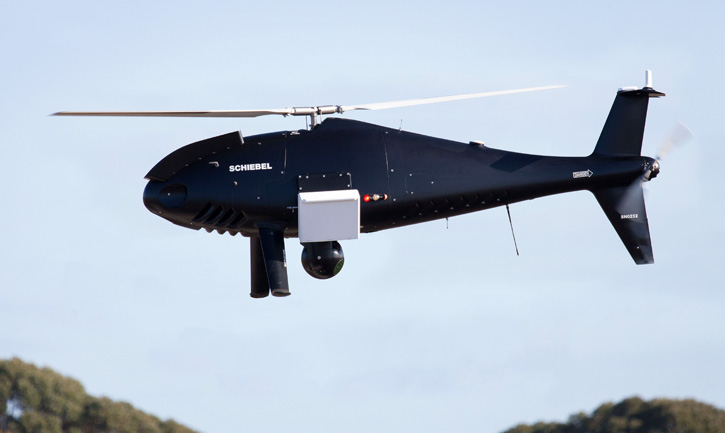Schiebel continues to diversify the sensor suits carried on the Camcopter S-100 unmanned small rotorcraft. In a recent demonstration the company has flown multiple sensors on a single platform, addressing a requirement from the Australian Navy.
The sensors carried on board on that mission included the SAGE Electronic Support Measures (ESM) and PicoSAR radar made by Finmeccanica – Selex ES and the Wescam MX-10 from L-3. The Camcopter S-100 can operate in day and night, under adverse weather conditions, with a beyond line-of-sight capability out to 200 km, both on land and at sea.
The trials that took place near Nowra, on the South East Coast of Australia, provided the Australians a demonstration how an advanced rotary wing UAS could be effectively used to support maritime and littoral Intelligence Surveillance Reconnaissance (ISR) tasks.
On the trials were operated in realistic maritime security scenarios in the littoral and open ocean the ESM and PicoSAR radar demonstrated how the use of such platform extends surveillance horizon of naval vessels and enhance situational awareness. The data provided by the ESM and radar sensors is crucial to understanding the maritime environment, which was proven in demanding conditions throughout the demonstration.

The CAMCOPTER S-100 is the only UAS in its class that is able to carry multiple sensors combined, enabling customers to gather images with an EO/IR camera, to detect and to identify electronic signatures with a ESM antenna and to use a Synthetic Aperture Radar (SAR) in real-time with only one system.
While ESM provides an effective solution for naval surveillance, it covers mainly radar and ultra-high frequency emitters, leaving the High Frequency band (3-30 MHz) immune from detection. Military and particularly paramilitary users and smugglers, are exploiting the HF communications band taking advantage of its inherent Beyond Line-Of-Sight (BLOS) communications and perceived immunity from communications interception.
A forthcoming demonstration will extend the frequency range coverage of the CAMCOPTER S-100, using Elta Systems’ ELK-7065 3D HF Band COMINT interception and geo-location system. The test with this payload is expected for during Q3 2015.
The ELK-7065 3D HF COMINT provides quick labelling and identification of HF signals, creating a reliable Electronic Order of Battle (EOB) picture and accurate geolocation. The revolutionary HF airborne antenna configuration, measuring merely 30 by 50 centimetres, is optimally suited for the CAMCOPTER. The patented compact HF system is currently going through installation phases.
Installed on the S-100 UAS, with automatic shipborne vertical take-off and landing (VTOL) capability, the ELK-7065 3D HF COMINT SENSOR can operate autonomously or as part of Intelligence, Surveillance and Reconnaissance (ISR) networks in joint operations.




















